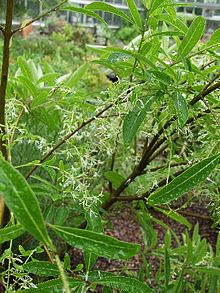| Fringetrees | |
|---|---|

| |
| Chionanthus pygmaeus | |
| Scientific classification | |
| Kingdom: | Plantae |
| Clade: | Tracheophytes |
| Clade: | Angiosperms |
| Clade: | Eudicots |
| Clade: | Asterids |
| Order: | Lamiales |
| Family: | Oleaceae |
| Tribe: | Oleeae |
| Subtribe: | Oleinae |
| Genus: | Chionanthus Royen (1753) |
| Synonyms[1] | |
| |
Chionanthus (/ˌkaɪoʊˈnænθəs/), common name: fringetrees, is a genus of about 140 species of flowering plants in the family Oleaceae.



The genus has a wide distribution primarily in the tropics and subtropics, but with three species extending north into temperate regions, one (C. retusus) in eastern Asia and two (C. virginicus and C. henryae) in eastern North America.[1][2] Most of the tropical species are evergreen, while the three temperate species are deciduous. Some botanists restrict Chionanthus to the deciduous, temperate species, treating the evergreen species in a separate genus Linociera, but apart from leaf persistence, there is no other consistent difference between them.
They are shrubs and small to medium-sized trees growing to 3–25 m tall. The leaves are opposite, simple. The flowers are produced in feathery panicles, with a corolla subdivided into four slender lobes; they are white, pale yellow, or tinged pink. The fruit is a drupe containing a single seed.[2]
- ^ a b Chionanthus Royen. Plants of the World Online. Retrieved 29 November 2023.
- ^ a b Flora of China v 15 p 293, genus Chionanthus